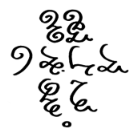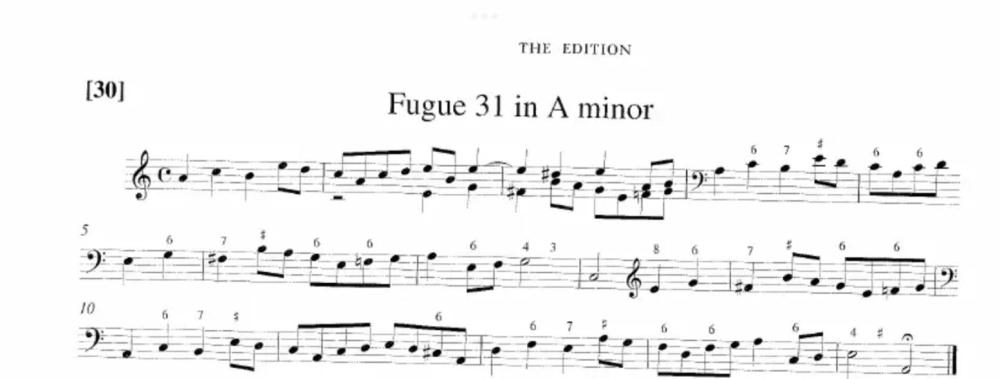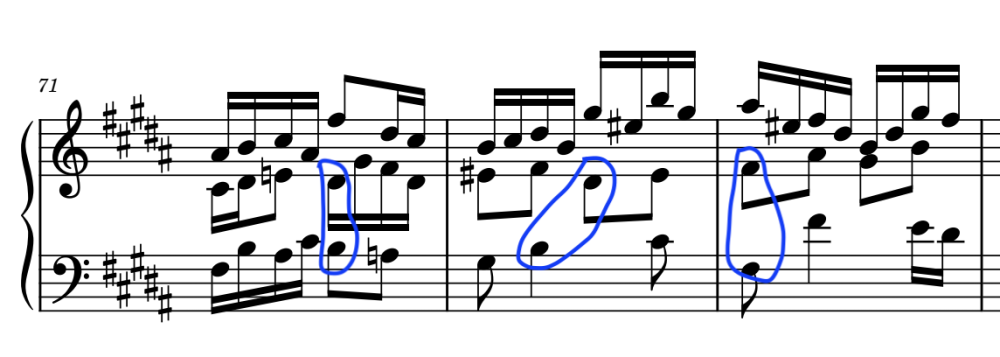All Activity
- Today
-
Updated score now with phrase markings in the voices denoting when to breathe. Though in m. 9-13 i left them out, because the singer could either breathe between 13 and 14 or after "way" in 11
-
@PeterthePapercomPoser Thank you for another review! Many of the annotated issues may be trivial but they're things that bug me whenever i've looked back at this piece The notes you gave on the annotations and the couple of other things really help me Yes, excuse me, I meant adding thirds and fourths or fifths and sixths, just to make the piano's solo bit sound richer Sure, if you would! Thank you again for the kind words and feedback. I think i'll post a revised pdf here in the replies with phrase markings in the voice as you suggested
-
Hi @user011235! I was about to go back to your Overture in G and move it to the Incomplete Works forum but decided against it because it doesn't seem like an incomplete work. It's just a juvenile piano work. This piece too I feel like actually sounds complete and should go in the vocal music forum - I can move it there if you want! This piece is quite wonderful btw. Once again, I feel like most of your annotations are trivialities. I think whether you put accents in the beginning is a matter of how you want your rendition to sound and how your program handles them. A person performing this on piano would know to bring out those notes slightly because they introduce a new chromatic note. Even just the fact that it's a chromatic note naturally brings it out and it's on a strong beat so yeah. At this tempo, the 16th notes in measures 11 and 31 are fine I think and real performers would probably take those phrases at a slight rubato tempo or slightly slower at least. I think the beam of the top voice in the left hand in measure 18 could be split between beats 3 and 4 to make it look nicer but other than that it's not really problematic either. At measure 19, I'm not sure what you mean by double stops. Double stops are chords that are usually played on two different strings on string instruments. That term is not usually used in piano music since you're not stopping the strings to produce the sound with a different length of string. Do you mean chords harmonized in 6th and 5ths? I didn't really notice that that passage lacked harmonic definition so unless you plan on beefing up the harmony throughout the rest of the piece to continue its consistency then I'd advise against it. In measure 26 I vote for it to be a grace note, but you're the composer - if you made it like two 16th notes, to me the 16th note motion might imply that the rest of the piece (at least the left hand) should be in 16th notes as well as a kind of variation of the beginning. I think measure 34 is a wonderful chromatic moment! Not too dramatic at all - or rather it's a very much welcome drama. Measures 44 - 46 I think your idea of using the phrasing marks as you have annotated isn't confusing at all and would quite natural for the pianist to interpret. What you could also add is phrasing marks for the voice which I think is way more important as it would let the singer know when you expect them to breathe and how long you expect them to sing without interruption. Thanks for sharing this wonderful pastoral song!
-
PeterthePapercomPoser started following The Pasture
-
user011235 started following The Pasture
-
This is a setting of Robert Frost's beautiful poem that I wrote around Easter 2018. Included is an annotated copy with things i'm unsure about. Any feedback is appreciated
-
Henry Ng Tsz Kiu started following Nocturne in Ab Major
- Yesterday
-
Thanks for the advice! The piece is somewhat constrained to what is easy for me to play technically at the moment
-
user011235 started following Nocturne in Ab Major
-
Very tender piece and performance, well done. My only suggestion would be to add a little more variety. A ton of variety isn't necessary in a short piece like this, where the whole thing feels like a single thought. But i would have liked to hear a little change from the pattern of simply one melody note every half measure. And I would've liked to hear those sixteenth notes last more than one measure. I felt like they had more to say.
-
Thanks!
-
PeterthePapercomPoser started following Nocturne in Ab Major
-
Thanks! Yes it’s from my phone camera
-
A very beautiful and sensitive work. I also find it harmonically rich. A good technique to intermingle the melody with the arpeggio. The sound is a bit muffled and strange, it seems to be a direct recording, isn't it?
-
Alt started following Nocturne in Ab Major
-
Nocturne written by me, any and all feedback is appreciated
-
I thought this was quite nice. Certainly would be a good opening movement for a sonata.
-
@PeterthePapercomPoser, thank you for your review! The annotations you clarified are appreciated. And I completely agree about the phrases, you put into words what i couldn't.
-
Henry Ng Tsz Kiu started following Overture in G
-
Hello @user011235! I don't see a problem with any of your annotated "mistakes" in your score. The key of C major is not a distantly related key and it's expected that closely related keys will be explored in the development. Another thing that sometimes happens in development sections is the occasional introduction of a new theme, which I think is okay as well. Perhaps the G-B third going to a D-F# third in bar 4 could be considered a contrapuntal mistake because the melody and it's doubling both leap by a fourth. Although I do remember that it's much much worse if two consecutive leaps of a 4th in the same direction occur. Alternating from one octave to another in the bass is a very common trick to introduce motion and musical interest to a bass line that would otherwise be more static. In measure 29 the bass can basically be analyzed as a 6/3 (1st inversion) chord since those are the chords that occur on the strong beats followed by passing 6/4 (2nd inversion) chords that don't change the triad. When you're outlining triads in this way it is not analyzed as harmonic motion since the chord stays the same it just introduces some welcome motion in the bass line. But all those annotations are but irrelevant details in comparison to what I perceive to be the more important problems that this composition has. The first thing that I assumed when listening to this is that it is not really meant to be a keyboard piece per se, but a keyboard reduction of an orchestral piece (hence the title of overture). I think it could really work well as such and many of the problems with whether the piece can be performed on a keyboard in its current state would be addressed in an orchestration. Another potential title for it that would be more appropriate for it as a keyboard work would be "Sonata in G" since it seems obvious to me that your goal was to write a piece in sonata form when you set out to write this piece. Now to the most difficult problem to deal with: the very awkward phrasing. It is not unusual in a Mozart or Haydn Sonata or Symphony to find the odd three, five or seven measure phrase here and there, sometimes because of elision where the end of one phrase is simultaneously the beginning of another. Other times because the theme group is coming to a conclusion and a three measure codetta rounds it out nicely etc. But your phrases after the introduction of the main theme group lack definition and direction and seem to just keep going and going for their own sake, reveling and celebrating in their own exuberance for too long when it might have been more appropriate to be succinct. This is not an easy problem to fix and it takes an evolved sense of musicality. Perhaps studying the galant schema might help to become more aware of the expectations espoused by different kinds of musical statements and how to properly and in due time conclude phrases? I've myself only begun to read Gjerdingen Galant Schemata book. But this is definitely a great start and has a lot going for it! Thanks for sharing.
-
PeterthePapercomPoser started following Overture in G
-
user011235 started following Overture in G
-
I've been grappling with whether i should post some old pieces of mine. On one hand, i really like a lot of the material in them, on the other, they're... well, old crxppy pieces XD. I looked them over to see if reworking them would be worthwhile - most of them I'd have to change so drastically that, especially since i've become so attached to them in their current state, i couldn't bring myself to do it. Others could be reworked, but when I tried doing so, I realized i didn't quite have the skillset. So, although i feel a bit icky about posting pieces that are littered with flaws that i'm already aware of, i think i'll be posting them one by one on here and hopefully perspectives of others will help. I also realized i could include an annotated copy of the score for each piece, with everything i can tell is wrong with it but don't know how to fix. Please enjoy the first piece, an overture i wrote in keyboard reduction style all the way back in 2018.
- Last week
-
Don't mind the out-of-place dynamics, missing parts in percussion, and instrument parts with lots of whole notes. Whole notes are palceholders, dynamics are from Mass-editing for the specific measures that they show up out of place in, and I've only added percussion to the main-motif areas of the score, so far. i.e. where it will be most prevalent.
-
bryceaporter joined the community
-

"Remembrance" | Arranged For Solo Piano :)
UncleRed99 replied to UncleRed99's topic in Piano Music, Solo Keyboard
Yes, I could tell musescore to only apply dynamics to the staff they're attached to, however, this would mean going back through the whole piece to add dynamics to both staves of the piano xD But yes, I use only Musescore to write music. Not so familiar with anything else, and the Muse Sound Engine is quite complex as it is. I believe it serves its purpose very well 🙂 Especially since I included the use of Spitfire LABS VST3 sounds on top of muse. I've also heard a lot about sibelius. How is that program? I understand it's a paid software. Muse provides their notation program for free, with a very solid team of devs on Github who are actively listening daily to the users. My old band director and I still talk time to time. He swears by Sibelius. lol Just wondering if it might be worth it to switch but I'm currently enjoying Musescore well enough... Only caveat I've noticed is larger orchestra scores tend to freeze quite frequently when making edits. How does Sib. respond to that? -
Yeah, maybe less parts would've been better, or, more suited for a small chamber ensemble rather than a full strings group. Imo, can't really go wrong with having more voices to work with / emphasize emotion with 🙂 But to each their own! That's the beauty of music. And Yea, I may start to do that now. I didn't really think much of it with this one, as the staves' names are mostly a given for anyone who's even a little educated on music composition or reading scores. I also agree with you on the MuseScore functions. However, the video creation function is exclusive to their website, and the score must be uploaded/published to the site first prior to it being able to do that for you. Nevertheless, Muse Group has come a long long way since the day I started using their program, Musescore 2.0, back when I was in high school... Can't believe they're on version 4.5 now, and it's great that there's a very active and alive community of developers on their github who all actively monitor and engage with feedback left on that site. I don't think they've let any issue or suggestion go un-acknowledged even if it's trivial or "stupid" lol And the icing on the cake, is it's free! Including the pretty dang solid playback engine + MuseSound VSTs they include for free with it. (Personally, for the piano and viola sounds in the piece attached to my OP, I'm using Spitfire LABS Intimate Piano and Fluid Viola playback rather than Muse's sounds, simply because once I got my hands on the Spitfire sounds for those instruments, everything I didn't like about the Muse sound versions was able to disappear with ease. If you listen closely, you'll also be able to hear in the piano part, the sounds of the hammers striking and returning to their resting positions, and you'll also hear the pedal being depressed and released. I thought that was an awesome touch of realism.)
-
So, after one long, sleepless night of nonstop composing, springtime inspiration has blossomed into what I would consider to be potentially one of my best pieces to date. The 2nd subject and its exposition actually were originally part of a totally different, unfinished fugue in F minor, and as such its thematic relevance isn't as prominent as that of the main subject, though significant in certain passages nontheless. Enjoy! YouTube video link:
-
- 1
-

-
This sounds great. It sounds like a piece we would hear at a luxury party. Excellent counterpoint all around in this piece.
-

Does this sound boring?
Atlantis_ replied to Atlantis_'s topic in Incomplete Works; Writer's Block and Suggestions
I need to figure out how to reduce the crackling in Cubase without lowering the strings volume. I tried adjusting the ASIO but no luck. Update: readjusted the reverb plug-in. It needs more readjusting. -
Hello! This is my realization of the 31st fugue from the Langloz manuscript. I would love to have some feedback on it. Fugue Realization: Langloz Manuscript 31.pdf Partimento bass is below
-

Fughetta in B major.
Fugax Contrapunctus replied to Fugax Contrapunctus's topic in Piano Music, Solo Keyboard
Thank you very much. I find it surprising that I've managed to make it more palatable to the ear than some other denser fugues of mine, but like you say it is only the masters that know how to manage contrapuntal density, Fortspinnung and diversity of approaches towards the simplest materials to grant their usage in each given piece the pinnacle of transformative richness. Those are abilities I still need a long time of honing and perfecting my craft and skills in order to acquire, let alone take them to the same level of greatness as our mighty forefathers. To be honest, I'm not so sure I agree with you here. Let's assume we did in fact exchange and cross voices at the points you noted: just in the first measure, we would have to make a descending tritone leap, and the rising bass from the lower F-sharp to the higher G-sharp in the 3rd beat/1st part of the 2nd beat in what is currently the middle voice would gives us a span larger than an octave in a continuous rising melody, which makes even less sense to me. Even if we take the twist the bass makes in the 2nd beat (rising to B and then descending to A-sharp before rising again) we would still have the melodic span of a major 7th in a non-chordal arrangement (A# C# D# G# instead of A# C# E G#, as would be more expected and acceptable in my opinion). Just now, after revising it again, I have made some changes to the bass and middle voice in b. 73 as follows (as well as adding an A-sharp so as to avoid parallel fifths between the middle and upper voices in the weak 16th-notes of the 2nd beat). I also slightly altered the upper voicing of the supertonic dominant chord before the finale for slightly more rhythmic variety. Regardless, thank you for your remarks, for even if the ones you made didn't make it into this (hopefully final) version, it certainly did make me come back and check for other potential mistakes, which I did end up finding and thus, correcting. 🙂 -

Fughetta in B major.
Luis Hernández replied to Fugax Contrapunctus's topic in Piano Music, Solo Keyboard
It sounds really delicious. The baroque counterpoint is fantastic. I love that you like to compose in that style. Sometimes there are fugues that “tire me out” but sometimes the opposite. Of course, I don't get tired of those of the great composers, haha. This one either, to be honest. Regarding what has been said about the tenths, I think it is common practice (and one of the difficulties in the interpretation) to cross the hand notes, although it is not indicated in the score, probably because in baroque the clarity of each voice predominates, not so in romanticism where these things are noted due to the density of texture. Greetings. -

Fughetta in B major.
Fugax Contrapunctus replied to Fugax Contrapunctus's topic in Piano Music, Solo Keyboard
Indeed, that is how I feel about it. Had I got discouraged by my initial lack of skill and abundant contrapuntal mistakes from the get go, I would have ended up disheartened and giving up on composition entirely. My career would simply had died before it could have even started, and I wouldn't have enjoyed composing so many of my fugues, as I set out to do from the very beginning. Regarding the 10ths in b. 71~73, the latest edition has those corrected alongside some minor voicing changes here and there as well. Thank you for your criticism and kind words, Henry 🙂 -
Hi Henry Thanks for your response! I’m not entirely sure what you mean by “advanced level”, but I’ve had the good fortune to teach many extraordinarily talented composers over the years, and some of my students have gone on to win very prestigious competitions and receive commissions from major orchestras and ensembles. What we cover in lessons would very much depend on your own goals as a composer. I can offer detailed, constructive feedback on works-in-progress, discuss and analyse important pieces of repertoire, explain and demonstrate techniques to take your music to the next level… whatever you want! If that interests you (or anyone else), you’re very welcome to message me through super prof. Patrick

.thumb.png.8b5b433a341551e913a34392660bc95b.png)


